Special Interests
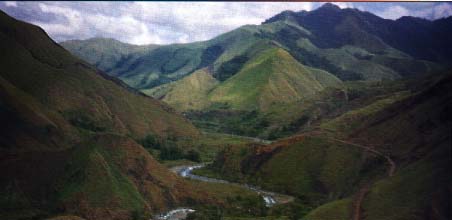 When a pastime becomes a pursuit, when the time, the money
and the opportunity present themselves to
indulge in such pleasures, Papua New Guinea
can offer a diversity of culture and physical
activities unattainable and unequalled anywhere
else in the world. When a pastime becomes a pursuit, when the time, the money
and the opportunity present themselves to
indulge in such pleasures, Papua New Guinea
can offer a diversity of culture and physical
activities unattainable and unequalled anywhere
else in the world.
Its' mountains, valleys, rivers and islands,
untouched by commercial development, provide
unlimited adventure and excitement for the
special interest visitor.
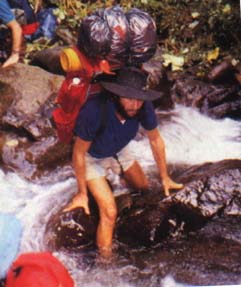 Diving enthusiasts around the world
keep coming back for what they describe
as the ultimate diving experience. Fishermen,
always looking for a bigger challenge, are
never disappointed. Reef waters, rivers
and estuaries abound with prize catches
of tuna, marlin, mackerel, black bass and
barramundi. Diving enthusiasts around the world
keep coming back for what they describe
as the ultimate diving experience. Fishermen,
always looking for a bigger challenge, are
never disappointed. Reef waters, rivers
and estuaries abound with prize catches
of tuna, marlin, mackerel, black bass and
barramundi.
Papua New Guinea is a bush walker's bliss.
There are hundreds of tracks traversing
the country, the most famous being the Kokoda
Trail, the scene of the bloodiest confrontations
of the Pacific campaign of World War 2.
Climb the highest mountain, Kayak in Madang,
cycle in New Ireland, explore caves in Kundiawa.
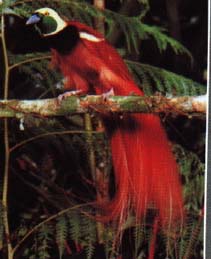 If you are batty about birds, PNG is the place
to be. Over 700 species of feathered fliers
flutter across our island including 38 of
the 43 known species of the exotic Bird
of Paradise. There are numerous other birds
of distinction including the cassowary Pigeon
which is the size of a turkey. Parrots of
Kaleidoscopic colours dot our towering trees. If you are batty about birds, PNG is the place
to be. Over 700 species of feathered fliers
flutter across our island including 38 of
the 43 known species of the exotic Bird
of Paradise. There are numerous other birds
of distinction including the cassowary Pigeon
which is the size of a turkey. Parrots of
Kaleidoscopic colours dot our towering trees.
Not all the colours of the rainbow have
been reserved for the birds as there is
an unlimited range of hues and shades to
be seen in our 2000 orchid species and countless
magnificent butterflies including the world's
largest, the queen Alexandra's Birdwing.
There are treasures of unusual artefacts,
museums, galleries and war cemeteries for
the historian and collector.
Whatever the pursuit, we guarantee the
experience of doing it in PNG will be fascinating
and rewarding.
Tourism Promotion Authority
PO Box 1291, Port Moresby 121, NCD
Papua New Guinea
Telephone:(675) 320 0211
Facsimile: (675) 320 0223
- Botanical
- Bird Watching
- Culture
- Trekking
- Cycling
- Canoe/Kayaking
- Golf
- Climbing
- Diving
- Fishing
For bookings, consult the
specific activities on the data sheet.
NATIONAL
PARKS AND BOTANICAL GARDENS
CENTRAL PROVINCE & PORT MORESBY
NATIONAL CAPITAL BOTANICAL GARDENS
Waigani Open 9.00am. to 3.00pm.
Monday to Friday and by appointment on weekends.
Currently undergoing extensive renovation
and expansion, the National Botanical Gardens
has the largest orchids collection in the
southern hemisphere. It is estimated that
there are over 3,000 species unique to Papua
New Guinea, with many new and unidentified
orchid species still found in lowland and
highland areas still being explored.
The orchid collection at the Botanical
Gardens is never out of flower. The peak
flowering season in Papua New Guinea is
between the months of December to March.
The Orchid House is laid out in the shape
of Papua New Guinea, the idea being to walk
through the different provinces of the country
looking at the orchids and plants unique
to the province.
Raised timber walkways lead through rainforest
areas to picnic area and an animal and bird
sanctuary.
VARIRATA NATIONAL PARK
Sogeri, Central Province
A thirty minute drive into the hills behind
Port Moresby, the park was established for
the conversation of natural plant communities
and animals in the wild and the protection
of scenic area and the Koiari Culture.
The park facilitates research and education
and has recreational areas including a Welcome
Haus, BBQ areas with picnic tables and shelters,
toilets, walking tracks, overnight lodges,
camp grounds, and a traditional Koiari tree
house.
MOITAKA WILDLIFE SANCTUARY
Moitaka, NCD
Situated near Jacksons airport on the outskirts
of Port Moresby, the sanctuary houses a
mini zoo with native birds and animals.
It has a research and education facility
for the study of crocodiles and was established
for the protection of endangered species
of wildlife in captivity.
There is an information centre and outdoor
recreation facilities. The public are able
to view crocodiles being fed at 3.00pm.
every Friday.
NAMANATABU HISTORIC RESERVE
Central Province
Established for the preservation of the
military design of the area's landscaping
and other significant historical relics.
A mule track, the only means of access
through the reserve up to Hombrum Bluff
is maintained.
HORSESHOE REEF MARINE PARK
Port Moresby
Established for the conservation of rare
marine habitat found only in Horseshoe Reef.
Research, education and recreational facilities.
KOKODA TRAIL
Central/Oro
National Park status has been given to
the Kokoda track for the preservation and
protection of this historical 90 kilometre
track. See separate data sheet for more
information.
EASTERN HIGHLANDS PROVINCE
MT GAHAVISUKA
Goroka
Established as a National Park for the
conservation of montane species of mountain
orchids and rhododendrons in the natural
habitat. There are walking tracks to the
summit of the mountain.
EAST SEPIK PROVINCE
CAPE WOM INTERNATIONAL MEMORIAL PARK
Wewak
Cape Wom was the site of the Japanese surrender
on 13th September, 1945. A memorial
park has been established to preserve the
remnants of the Japanese troops who died
there. The Park is used for educational
and research purposes and has provisions
for outdoor education. War relics can be
viewed here. There are walking tracks, BBQ
shelters, picnic tables and toilet facilities.
MOROBE PROVINCE
McADAM, WAIF
Bulolo/Lae
Established for the protection of the last
virgin stand of Arancarta forest. Hoop and
Klinki Pine varieties still remain in Bulolo/Wau
areas. Used for education and research.
There is an outdoor recreation area and
scenic walking tracks.
WESTERN HIGHLANDS PROVINCE
BAIYER RIVER SANCTUARY
Mt Hagen
Established in 1968 for the protection
in captivity of endangered species of wildlife
fauna and to encourage breeding whilst in
captivity. Used for research and education.
Facilities include an outdoor recreation
area, welcome haus, picnic shelters and
tables, BBQ, a guest lodge, toilet facilities,
library and laboratory.
JIMI VALLEY NATIONAL PARK
Banz
Established in 1986 for the preservation
of original forest area.
WEST NEW BRITAIN PROVINCE
TALELE ISLAND
Kimbe
Established in 1973 as a nature reserve
for the conservation of land and marine
habitat.
TREKKING
IN PAPUA NEW GUINEA
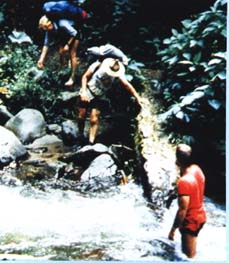 Papua New
Guinea has long been a popular destination
for trekking, mountain climbing and bushwalking.
With largely unspoilt mountains, rivers
and forest, as well as having been the focus
for attention in World War 2 and the vast
cultural and social resources, Papua New
Guinea is an ideal place for both the fit
trekking enthusiast or weekend bushwalker
to visit. Papua New
Guinea has long been a popular destination
for trekking, mountain climbing and bushwalking.
With largely unspoilt mountains, rivers
and forest, as well as having been the focus
for attention in World War 2 and the vast
cultural and social resources, Papua New
Guinea is an ideal place for both the fit
trekking enthusiast or weekend bushwalker
to visit.
Both full scale, professional standard
treks and scenic bush walks of a few hours
duration are available. Being largely unserviced
by the tourism industry, the trekking, bushwalking
and adventure market in Papua New Guinea
has great potential. Most centres in PNG
can produce treks and bushwalks of undeniable
world class quality and beauty.
The Highlands region is famous for its
tall mountains with scores of readily accessible
peaks. Mt Wilhelm at 4509 metres, is the
most popular target for mountain climbers
with good road access to Kegsugl village
from Kundiawa and National Parks huts for
climbers to stay in. Recently the focus
of PNG Tourism Promotion Authority sponsored
guide training activities, the Mt. Wilhelm
region is becoming the focus for individual
and guided trekkers. Whilst being accessible,
Mt Wilhelm is not easy and guides should
be taken to assist climbers.
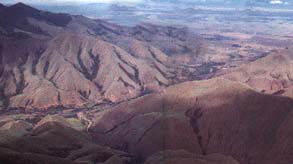 From the central
Highlands city of Mt. Hagen, the towering
peaks of Mt. Giluwe and Mt. Ialibu (both
volcanic plugs), Mt. Hagen, Mt Ongo, Mt
Kubor and Mt Kine Kaino Ku are all accessible.
The Bismarck and Kubor Range both offer
great trekking. Fifteen days hard trekking
would see an expedition walk from the highlands
town of Kompiam in Enga province to the
Yuat River in East Sepik province where
canoes would take the expedition on to Angoram.
Several tour companies exist in Mt. Hagen
which can assist the trekker. Goroka is
the centre for several good climbs with
Mt. Michael and Mt. Gahavisuka being accessible. From the central
Highlands city of Mt. Hagen, the towering
peaks of Mt. Giluwe and Mt. Ialibu (both
volcanic plugs), Mt. Hagen, Mt Ongo, Mt
Kubor and Mt Kine Kaino Ku are all accessible.
The Bismarck and Kubor Range both offer
great trekking. Fifteen days hard trekking
would see an expedition walk from the highlands
town of Kompiam in Enga province to the
Yuat River in East Sepik province where
canoes would take the expedition on to Angoram.
Several tour companies exist in Mt. Hagen
which can assist the trekker. Goroka is
the centre for several good climbs with
Mt. Michael and Mt. Gahavisuka being accessible.
Caving is now receiving international attention
with Papua New Guinea possessing several
of the deepest cave systems in the world.
The Southern Highlands has several high
systems and the islands of New Ireland and
New Britain also have explored and unexplored
cave systems.
Many of the nations towns and government
stations could be starting points for mountains
climbing expeditions. A glance at the map
reveals simply dozens and dozens of mountains
in excess of 3,000 metres, many of which
could be conquered by fir trekkers in a
day or two at most. New Britain has many
extinct and active volcanoes worth a climb
and the Oro Province is similarly rich in
good climbing.
The islands have good potential for long
distance coastal treks, with villages being
the ideal campsites. The interior of the
islands and coastal regions offer largely
undisturbed rain forests and cross island
treks are possible with small towns being
the start and finish points.
The old Bulldog trek and the famous Camel
rally has trekked its way through some of
the mountain roads. Kokoda and Port Moresby
itself can be the jumping off points for
the world famous Kokoda Trail trek. In World
War 2, the Kokoda Trail was the scene of
bitter fighting and the trail is now a national
park in itself. The record is less than
24 hours however treks of 5 to 15 days are
the most common trek length. The usual trek
along the Kokoda Trail is about 10 days
with Kokoda being the usual start point.
Many trekkers carry their own packs however
carrier/guides can be hired in villages
along the route. There are number of points
along the trail where light aircraft airstrips
and regular or chartered flights are available
so trekking the Kokoda Trail can be undertaken
in sections. Several tour companies offer
organised tours along the trail and for
safety reasons this is advisable.
Mountain areas near village resorts hold
environmental, floral and fauna delights
unmatched by other destinations.
Moresby Motu people, in their Hula voyages
and the Trobriand Islanders and their Kula
voyages have both been emulated by tourist
adventurers. The Arowe and Kombe Islanders
of New Britain both completed major trans
island trading voyages in large sail powered
dugout canoes and these would be ideal tourist
adventures. The Sepik river with its 1200
kilometres village-studded length has been
the scene for many an adventurer purchasing
a dugout or two, lashing them together and
embarking of lifetime down the broad waters
of the swirling Sepik. Of course a motorised
canoe trek of the river is also an option
with overnight stays in village houses,
being a feature. Manus is now a growing
centre for the adventure sport of sea Kayaking
and trek around the islands is a new adventure
for the enthusiast. The world sea Kayaking
championships are now being mooted for Manus.
Trekking, with it adherent adventure sports
of sailing, biking, caving, motor biking,
rallying, bushwalking has an ideal base
in Papua New Guinea. With its great forested
mountains, remote islands and beaches, long
winding river systems and unique cultural
activities, the trekker and adventurer can
find what they want in Papua New Guinea.
The potential is great and the increased
in village based tourism will mean the previously
inaccessible areas will now be available
for the trekker, adventurer or enthusiast
to explore at will. Cooperation and collusion
with the local landowners and farmers is
always recommended. Contact the provincial
tourism authority for more information on
negotiating with local landowners and guides.
KOKODA
TRAIL
Today the 90 kilometre Kokoda Trail is
the most popular recreational walking track
in Papua New Guinea. It is a rugged, sometimes
hazardous series of steep ridges and muddy
gullies - one of the world's true adventure
treks.
The Kokoda Trail was originally used by
gold miners during the 1890s, walking north
from Port Moresby to the goldfields of Yodda
and Kokoda. During the Second World War,
the trail gained notoriety as the scene
of some of the most bitter fighting.
The Japanese had decided to take Port Moresby
by a totally unexpected back door assault.
The plan was to land on the north coast
near Popondetta, travel south to Kokoda
and then march up over the central range
to Sogeri and down to Port Moresby. Two
months later, on 16 September 1942, their
supply lines stopped and they withdrew.
The final push to retake the beachheads
at Buna and Gona saw the Japanese not so
much defeated as annihilated. It has been
estimated that of their total force of 16,000
men only about 700 survived the fighting,
disease and starvation.
The beginning of the track is marked by
a memorial stone at Owers' Corner, along
the Sogeri Road. Day trippers from Port
Moresby can do a one hour walk along the
trail towards the Goldie River. Those continuing
will climb the "Golden Stairs"
over the top of Imita Ridge, not the steepest
or highest of the mountain ranges along
the trail, but a savage sample of things
to come. The trail climbs up the Ioribaiwa
Ridge, through abandoned villages. This
was the point where the Japanese forces
stopped and withdrew, less than 20 kilometres
from Port Moresby.
The halfway mark is at the village of Efogi,
where the altitude reached brings a crispness
to the evening air. From here the track
winds through numerous garden plots and
open grassland before reaching Mount Bellamy,
an eerie place, where boots make sound along
the track which is now a tunnel of trees
and vines festooned with moss. The moss
hangs in streams from dead and living trees
with little sunlight to pierce the gloom.
Until the war, this was a taboo place and
avoided by all.
The campsite is 45 minutes walk from the
main trail on the track into the old air
drop zone of Myola. Once you stop walking
the cold of the altitude is apparent. Humidity
is still high which, accompanied by cold
and mist, means there is a continuos patter
on the leaves of falling droplets of condensation.
Trek through swamp and marshy ground, cross
rivers spanned by log bridges and causeways,
climb through rugged country, endlessly
climbing and plugging, enjoy remarkable
panoramas. Stop at villages and get to know
the locals, always eager to talk to visitors.
The walk ends at the village of Kokoda.
Kokoda was defended by the Australians on
a tongue like plateau which overlooks the
land below. On this plateau are a number
of memorials and a small museum.
All travel on the Kokoda Trail is hard,
but the journey can be organised into sections
which are manageable by persons of good
health and average "jogger" fitness.
Tour operators organise eleven day trips
along the trail, walking at a moderate pace.
Alternatively porters and guides, recommended
as necessary, can be organised. Good equipment,
comfortable boots, wet weather gear and
a medical kit should be carried.
The Australian Government in conjunction
with Rotary International have recently
completed the construction of aid posts
and a medical centre at Kokoda as a memorial
to those who died.
The walk is not recommended during the
wet season. It can be extremely slippery
and the rivers are often too high to cross
safely. August and September are the best
time to walk. Most trekkers walk from the
south to the north.
THE
RAINFOREST HABITAT
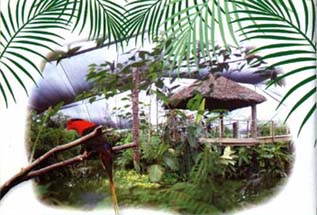 The rugged mountains near Lae are covered in
a tangle of rainforest which is home to
an assortment of tropical birdlife, butterflies,
orchids and creatures which crawl, fly and
jump. The rugged mountains near Lae are covered in
a tangle of rainforest which is home to
an assortment of tropical birdlife, butterflies,
orchids and creatures which crawl, fly and
jump.
The dark and steamy atmosphere of this
impenetrable rainforest jungle is recreated
at the Rainforest Habitat only nine kilometres
from the centre of Lae.
Forest trees, local bananas, tree ferns,
flowering orchids and ginger are amongst
the 15,000 native and exotic plants found
spreading upwards to form a natural protective
canopy for the diversity of animals and
birdlife below.
Forest wallabies, flying foxes, lizards,
green frogs, butterflies and crocodiles
add to the large variety of wildlife. The
"raunwara" (waterhole) in the
centre of the Habitat has species of native
fish and turtles and adjoins a swamp where
ducks and other waterbirds live.
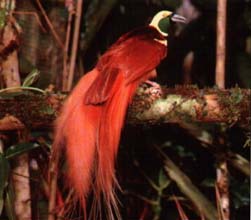 Over thirty species
of birdlife, including the magnificent Raggiana
Bird of Paradise, Queen Victoria's Crowned
Pigeons, hornbills, parrots, brush turkeys,
cassowaries and fruit doves can be found.
Raised walkways and waterfalls add to the
comfort and enjoyment of the jungle walk.
Refreshments are served in the cool fragrance
of rainforest foliage. Over thirty species
of birdlife, including the magnificent Raggiana
Bird of Paradise, Queen Victoria's Crowned
Pigeons, hornbills, parrots, brush turkeys,
cassowaries and fruit doves can be found.
Raised walkways and waterfalls add to the
comfort and enjoyment of the jungle walk.
Refreshments are served in the cool fragrance
of rainforest foliage.
The Rainforest Habitat, situated on the
campus of the University of Technology,
with an area of more than 3,000 square metres
is covered by an eleven metre high shade
cloth canopy to create an artificial rainforest
environment for the study and preservation
of native flora and fauna. It forms part
of the Unitech owned insect Farming and
Trading Agency (IFTA).
FLORA AND FAUNA
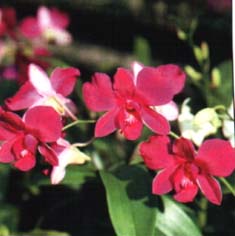 A great percentage
of Papua New Guinea's land mass is covered
with a dense blanket of rainforest - an
exotic tangle of vines, creepers, flowers,
plants and trees. Wild orchids blaze against
a verdant green background of rainforest
canopy. Papua New Guinea has a greater number
of orchid species than any country in the
world. A great percentage
of Papua New Guinea's land mass is covered
with a dense blanket of rainforest - an
exotic tangle of vines, creepers, flowers,
plants and trees. Wild orchids blaze against
a verdant green background of rainforest
canopy. Papua New Guinea has a greater number
of orchid species than any country in the
world.
Bird life is prolific. The most famous
is the Bird of Paradise. Of the 43 known
species of Birds of Paradise, 38 are found
in Papua New Guinea. These brilliantly coloured
birds perform bizarre ritualistic and mating
dances and were hunted by early traders
for their feathers.
Most animals in Papua New Guinea are marsupials,
relatives of those found in Australia.
Although not indigenous to Papua New Guinea,
pigs are valuable source of food and an
important status symbol among Highlands
tribal people. Rusa deer are a more recent
arrival, brought into the Indonesian province
of Irian Jaya by Dutch colonists, they crossed
into the southwest part of the country around
Western and Gulf Provinces.
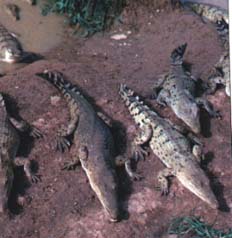 There
are about 200 species of reptiles, including
thirteen different turtle species and 100
different types of snakes. There
are about 200 species of reptiles, including
thirteen different turtle species and 100
different types of snakes.
Papua New Guinea has a multitude of insects.
In 1978 the Insect Farming and Trading Agency,
at Bulolo in Morobe Province, was established
by the PNG Division of Wildlife to initiate
and control the local insect farming industry
and further market it overseas. It ensures
strict controls of quality and accompanying
scientific data. It is the only organisation
permitted by the Papua New Guinean Government
to farm and trade insects.
Research workers at the IFTA have discovered
many new species. Special area of research
have included detailed studies of all native
birdwing butterflies and a study of the
plight and conversation strategies needed
to save Queen Alexandra's birdwing, ornithoptera
alexandrae, the largest known butterfly
in the world, which is found only in Papua
New Guinea's Oro Province.
PAPUA
NEW GUINEA'S BUTTERFLIES
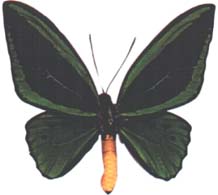 The region of New Guinea is renowned for the
beauty, size and variety of its insects
and, in particular, its butterflies. Especially
well-known among naturalists, entomologists
and collectors are the magnificent birdwing
butterflies which are only found in this
region of the world. The region of New Guinea is renowned for the
beauty, size and variety of its insects
and, in particular, its butterflies. Especially
well-known among naturalists, entomologists
and collectors are the magnificent birdwing
butterflies which are only found in this
region of the world.
Papua New Guinea is home to more than 700
different species of butterflies. This is
more than two times the number of species
found in the continent of Europe which is
about six times larger than PNG. The reason
for this diversity of butterflies and insects
in general is the tropical climate and the
mountainous topography.
The many mountains valleys and islands not
only offer a variety of different habitats
but also lead to the evolution of many new
species which are peculiar to Papua New Guinea
and are sometimes only found in a restricted
area. One example are many of the Delias species
which are only found on certain mountain peaks,
another is the largest butterfly of the world,
Queen Alexandra's birdwing (ornithoptera alexandrae)
which is confined to the lowland rainforest
of the Popondetta region in Oro Province.
ew
Guinea's insect fauna include the Hercules
Moth (Coscinocera Hercules) which is the
largest moth in the world, or one of the
largest stick insects in the world, Eurycnema
Goliath.
The caterpillars of butterflies feed on
many specific foodplants, some of them poisonous
to large animals like the milkweeds or the
alkaloid-rich Aristolochia vines which represent
the food plants of the birdwing caterpillars.
Storage of these poisons provides these
caterpillars with protection against predators
and sometimes even makes the adult butterflies
distasteful to birds. Many of these butterflies
have bright aposematic colouration to warn
potential predators of their bitter taste.
Palatable species sometimes copy these
colourations to trick predators and gain
some protection for themselves (like the
blue day-flying moth Alcides agathyrus w
which is though to copy the swallowtail
Papilio laglaizei) whereas other species
(like the leaf-like coloured Doleschallia)
prefer a cryptic appearance to escape their
enemies.
Although different species of butterflies
have developed various strategies to escape
their many predators and parasites or to
adapt to changing conditions of their environment,
their survival is easily threatened by destruction
of their natural habitats, in particular
the rainforests, through human activities.
An example is the rare Queen Alexandra's
birdwing which is endangered by logging
operations and agricultural clearing of
the rainforest. Fortunately this species
is now the subject of a conservation programme
which hopefully will ensure its survival.
SPORT
AND GAME FISHING
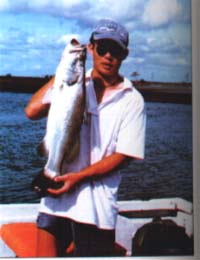 From the rivers or from the oceans, Papua New
Guinea has the ultimate fishing experience.
The coastal waters around the Madang, East
and West New Britain and New Ireland abound
in blue and black marlin, sailfish and dogtooth
tuna. From the rivers or from the oceans, Papua New
Guinea has the ultimate fishing experience.
The coastal waters around the Madang, East
and West New Britain and New Ireland abound
in blue and black marlin, sailfish and dogtooth
tuna.
In the waterways near Kandrian, freshwater
fisherman can take on the famous Papuan
Black and Spot Tail Bass found only in Papua
New Guinea. If barramundi is your game,
stay at the remote Bensbach Lodge near the
border of Irian Jaya. There's saratogo and
ox eye herring to play with too.
For your fishing trip contact the following
operators and fishing clubs:
MADANG PROVINCE
REEL FISH CHARTERS
Contact: Brett Middleton
MV "Talio"
PO Box 521
Madang 511, Madang Province
Papua New Guinea
Telephone: (675) 853 7496
Fax: (675) 853 7468
MV "Talio" maintains state of
the art equipment, from 8kg to 60kg tackle
and electronics including radar, GPS and
top of the range sounder. It has maximum
speed of 29 knots. With so much fishing
within range, on any given day anglers can
enjoy a variety of world class sport.
"Talio" owner/skipper Brett Middleton,
who cut his teeth in legendary Cairns big
game fishing, further enhances your strike
chances with his expert local knowledge.
Coastal currents can run at 5 knots, carrying
sailfish, yellowfin, mahi mahi, mackerel
and many more species to within 100 yards
of the shore. Sailfish in particular hunt
in packs here, in number and sizes seldom
before seen in the South Pacific.
On remote reefs you can fish for dogtooth
tuna, spanish makerel, giant trevally, coral
trout, and more sailfish. There's a wealth
of options all year round. The area is a
paradise for the fly, light, medium and
heavy tackle angler.
For the ultimate Papua New Guinea fishing
experience, combine a "Talio"
Madang adventure with a trip to Arrjim Island
Bass Fishing Camp on the remote south coast
of West New Britain. Internationally renowned
for its black and spottail bass. These mighty
opponents are the strongest freshwater species
in the world and they offer the supreme
challenge for the plug caster.
WESTERN PROVINCE
BENSBACH WILDLIFE LODGE
PO Box 6940, Boroko 111, NCD
via Daru, Western Province
Contact: John Ramshaw
Telephone: 323 4467
Facsimile: 323 4467
Wildlife/ Birdwatching Packages
Fishing Packages
The packages allow for 4 persons per boat.
Royalty on fish kept is 60 toea per kg (whole
fish). Guides will clean, fillet and pack
fish. As Bensbach carries a limited amount
of gear it is recommended that fishermen
bring their own equipment.
Bensbach encourages tag and release. The
season runs from June/July to October/November.
Barramundi is the principal catch, with
Saragota and Salmon a distant second and
third.
Hunting
8 hunters, maximum at any one time. Royalty
on deer is K2.00/head, bag limit is five
per hunter. Guns and ammunition are NOT
provided by Bensbach.
For overseas clients the lodge will arrange
a licence and Customs approval to import
ammunition and a firearm. The form for a
licence has to be filled out by the hunter
and signed at a local police station and,
along with 2 photographs, sent to the lodge.
The licence and customs approval is sent
to the hunter/group leader. Allow up to
a month for licence and customs approval.
Hand guns are not allowed.
Prices are per person and include accommodation,
meals, laundry and boat/guides. Drinks are
extra. Land transport is an extra and availability
depends on the weather.
For charters, the pilot's daily rate is
half, provided the pilot does not partake
in the groups activities. Children under
12 are half price.
Royalties are paid to the village people
within the Tonda Wildlife Reserve.
Payment can be made in cash or travellers
cheque only as, due to the remoteness of
the Lodge, processing of credit cards will
takes up to four months.
The weather is tropical - days 30 to 34
degrees Celcius, night 20 to 24 degrees
Celcius. Wet season is December to March.
Casual, light clothing offering good covering
is the most comfortable. Don't forget hats,
sun-glasses and suntan lotions/creams.
M.B.A. fly to Daru from Port Moresby and
Kiunga Monday to Saturday. Air Niugini fly
Port Moresby to Daru Monday, Wednesday and
Saturday. The Bensbach strip is closed at
present but Sunwest Aviation will fly charters
to Weam, a strip two hours upstream from
the lodge, from Daru. Other charters can
be organised from a number of operators
in most major centres in Papua New Guinea
and Cairns, Australia.
For further information, contact the Tourism
Promotion Authority.
FISHING CHARTERS
MOROBE PROVINCE
HUON GULF CHARTERS
PO Box 1104, Lae 411, Morobe Province
Contact: Jan Hardie
Telephone: (675) 472 2745
Facsimile: (675) 472 6175
MOROBE SEA CHARTERS
PO Box 245, Lae 411, Morobe Province
Contact: Fred Cook
Telephone: (675) 472 3647
Facsimile: (675) 472 5788
NATIONAL CAPITAL DISTRICT
PORT MORESBY GAME FISHING CLUB GANTRY
PO Box 5028, Boroko 111, NCD
Contact: Ken Weber
Telephone: 321 1391
BOROKO SPORTS FISHING CLUB
PO Box 5280, Boroko 111, NCD
Contact: Rebecca Geoghegan
Telephone: (675) 323 5513
Facsimile: (675) 323 5535
|